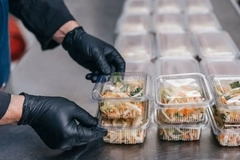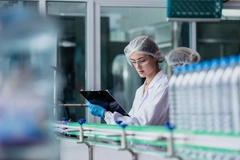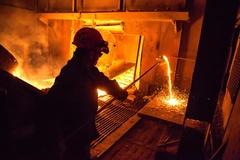Danone thermoforms PET for a niche line of products

Of the millions and millions of single-serve yogurt containers filled each year, the vast majority are polystyrene, both the preformed variety and those formed from roll stock on a thermoform/fill/seal system. One notable exception is a new line at Danone’s plant in the French city of Pays de Bray, about 90 minutes northeast of Paris.
Of the millions and millions of single-serve yogurt containers filled each year, the vast majority are polystyrene, both the preformed variety and those formed from roll stock on a thermoform/fill/seal system. One notable exception is a new line at Danone’s plant in the French city of Pays de Bray, about 90 minutes northeast of Paris.
That’s where an Arcil system is forming round bowls from roll-fed PET. To appreciate this operation for what it represents and understand why it was installed, it helps to look back to 1998, when Danone launched a similar bowl-shaped container for a premium range of yogurts. The unusual bowl shape and the use of a clarified PP resulted in a clear container. This was part of the premium positioning that Danone was after on this particular range of yogurt desserts.
“We worked with Arcil some years back to develop f/f/s for a PET bowl, but then we stopped,” says Marechal. “Recently they approached us again with what they described as an improved process that produces two cups joined at the top that can be easily snapped apart by the consumer, so in 2011 we installed the system that you see in our Pays de Bray plant.”
The PET line at Pays de Bray forms, fills, and seals cups eight across and four in the machine direction at about 600/min. Sophisticated robotics contribute to the line’s ability to run at this rate. But before jumping ahead to the robots, it pays to take a good look at the Arcil system, where a number of fascinating things take place.
Decontamination
Speaking of the web, which is 1.2 mm thick and is supplied by Paccor, it’s not as clear as it might be. Why? Because the EBM bowl made of clarified PP that preceded the PET bowl has a slight milkiness to it. Danone’s Marketing Department didn’t want two different looks—one milky and one clear as glass—confusing the marketplace. So Paccor adds the smallest amount of colorant to the masterbatch so that the bowls thermoformed from PET look just like the ones extrusion blow molded from PP.
One unusual thing about the Arcil system, at least where conventional tf/f/s systems are concerned, is that the PET sheet is cut into strips before it enters the forming station.
Once cut into strips that are 78 mm wide, the PET is transported through the system by chain grippers on left and right much like those used for sheet transport in conventional thermoforming. A series of nine heating stations condition the PET material before it enters the forming station.
Once in the mold, cups are formed by vacuum and plug assist to a depth of 50 mm.
The bowl shape requires what Arcil calls “open-mold tooling.” Why? Because this particular container is widest at its center. Usually in thermoforming, the widest part of the piece being formed is right at the top, so the forming tool just has to drop straight down to release freshly formed cups. Danone’s bowl is quite different. It’s narrower at the top and bottom but wider in the center. So the only way to get the formed part out of the mold is to have the sidewalls of the mold open about an inch in each direction. This is what Arcil means by the term “open-mold tooling.” It lets the formed PET container exit gracefully from the mold.
It’s because the mold needs to be opened that the PET sheet needs to be cut into strips. In cutting the strips and leaving a gap between them, the proper pitch is created for the thermoforming tools to open and close without having a whole lot of excess sheet wasted in between.
Filling and heat sealing
As the pairs of formed cups are cut from their strips, the scrap matrix from which they’re cut drops onto a belt conveyor that runs at a right angle and into a collection bin. The cups drop about 12 inches into a pocketed reciprocating platform that advances them forward to a station where an Aries picking head takes over. Its end effector consists of 48 vacuum pickup cups. With each stroke, it lifts 48 cups and puts them on the infeed conveyor belt of an Aries collator.
The Aries collator has four delta style Quattro robots from Adept that pick cups from their six-across mass flow and place them on a parallel conveyor in a single file. The other assignment executed by the four Quattro robots is the placement of one pair of cups on top of another. It’s in this stacked format that four bowls are ready to be wrapped in a paperboard carrier on a machine also supplied by Aries.
Paperboard carrier blanks are picked from a large magazine by means of a rotary vacuum cup device and placed down near floor level on a conveyor that angles upward until it carries the flat blanks right under the stacked pairs of bowls that are on the conveyor above. Mechanical tuckers automatically fold the paperboard around the bowls and a hot melt glue is applied on the bottom flaps to finish the application of the carrier.
Source: Danone











